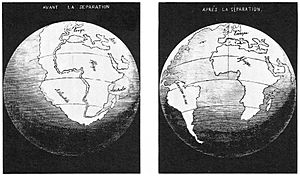Continental drift facts for kids

Continental drift is an old but very important scientific theory. It explains how the Earth's continents have moved over millions of years. This idea was first suggested by Abraham Ortelius in 1596. Later, a German geologist named Alfred Wegener fully developed the theory in 1915.
Wegener's theory said that large pieces of the Earth's outer layer, called the crust, slowly slide around. They move on top of a hotter, denser layer called the mantle. Today, the idea of continental drift is part of a bigger theory called plate tectonics. Plate tectonics helps us understand even more about how our planet changes.
Contents
Clues from the Past
Scientists found many clues that supported the idea of continental drift. These clues made the theory seem very believable, even before we knew exactly how the continents moved.
Matching Fossils and Rocks
- Fossils: Imagine finding the same plant and animal fossils on continents that are now far apart! For example, fossils of a fern called Glossopteris have been found in Australia, South America, Antarctica, India, and Africa. This suggests these lands were once connected.
- Rocks: Scientists also found identical types of minerals and rocks on different continents. For instance, the rocks of Table Mountain in South Africa are the same as mountains in Rio de Janeiro, South America. This matches how Africa and South America would fit together.
- Shapes: If you look at a map, you can see that the shapes of some continents fit together like puzzle pieces. The west coast of Africa and the east coast of South America are a great example.
Geological Activity
Continental drift helps explain why we see volcanic activity, mountain building, and earthquakes in certain places. These events happen where the Earth's crust is moving and interacting.
How Does it Work?
The main force that makes continents move comes from inside the Earth. Heat from the mantle rises towards the surface. This creates a slow, circular movement of material, like water boiling in a pot. This process is called convection.
Two very important things happen because of this convection:
- New Crust Forms: In some places, like the Mid-Atlantic Ridge, new crust is constantly being made. This pushes the existing plates apart.
- Old Crust Disappears: In other places, where plates crash into each other, one plate can slide underneath another. This process is called subduction, and it removes old crust back into the mantle.
These two actions, creating new crust and removing old crust, are the main drivers behind the slow but powerful movement of continents across the Earth's surface.
Images for kids
-
Abraham Ortelius by Peter Paul Rubens, 1633
See also
 In Spanish: Deriva continental para niños
In Spanish: Deriva continental para niños




